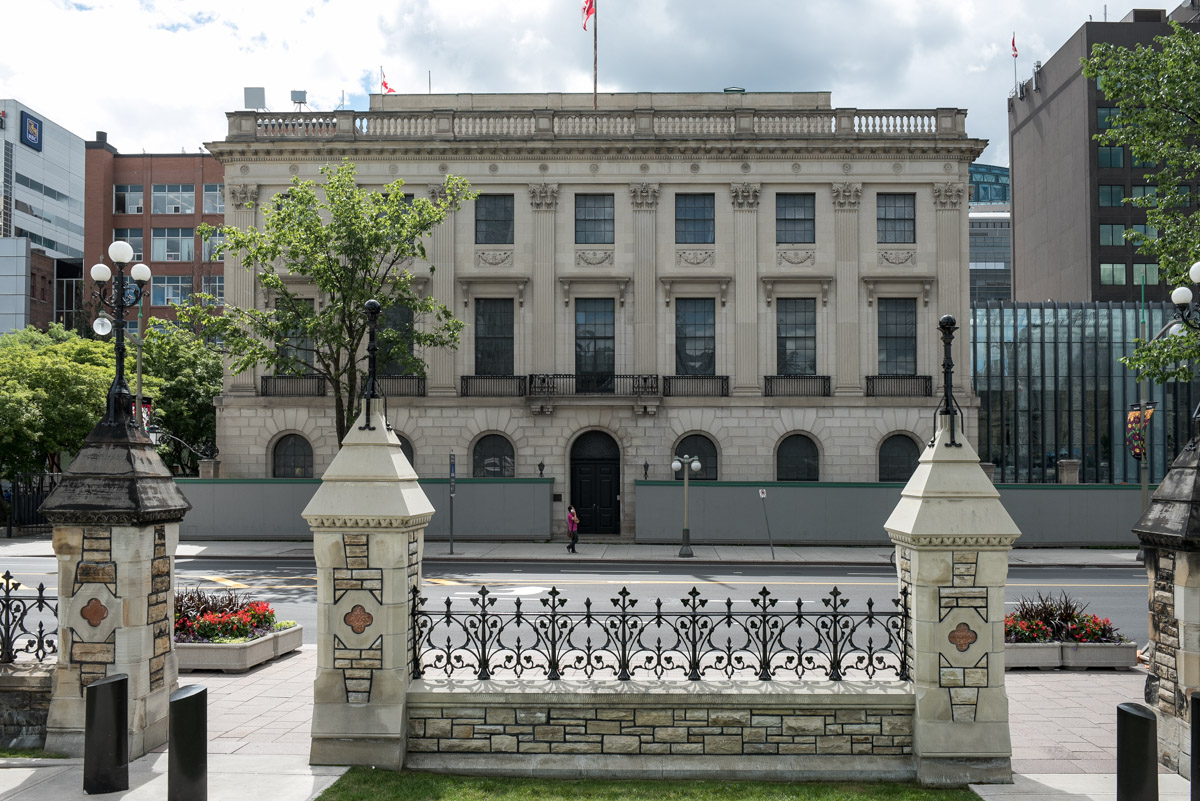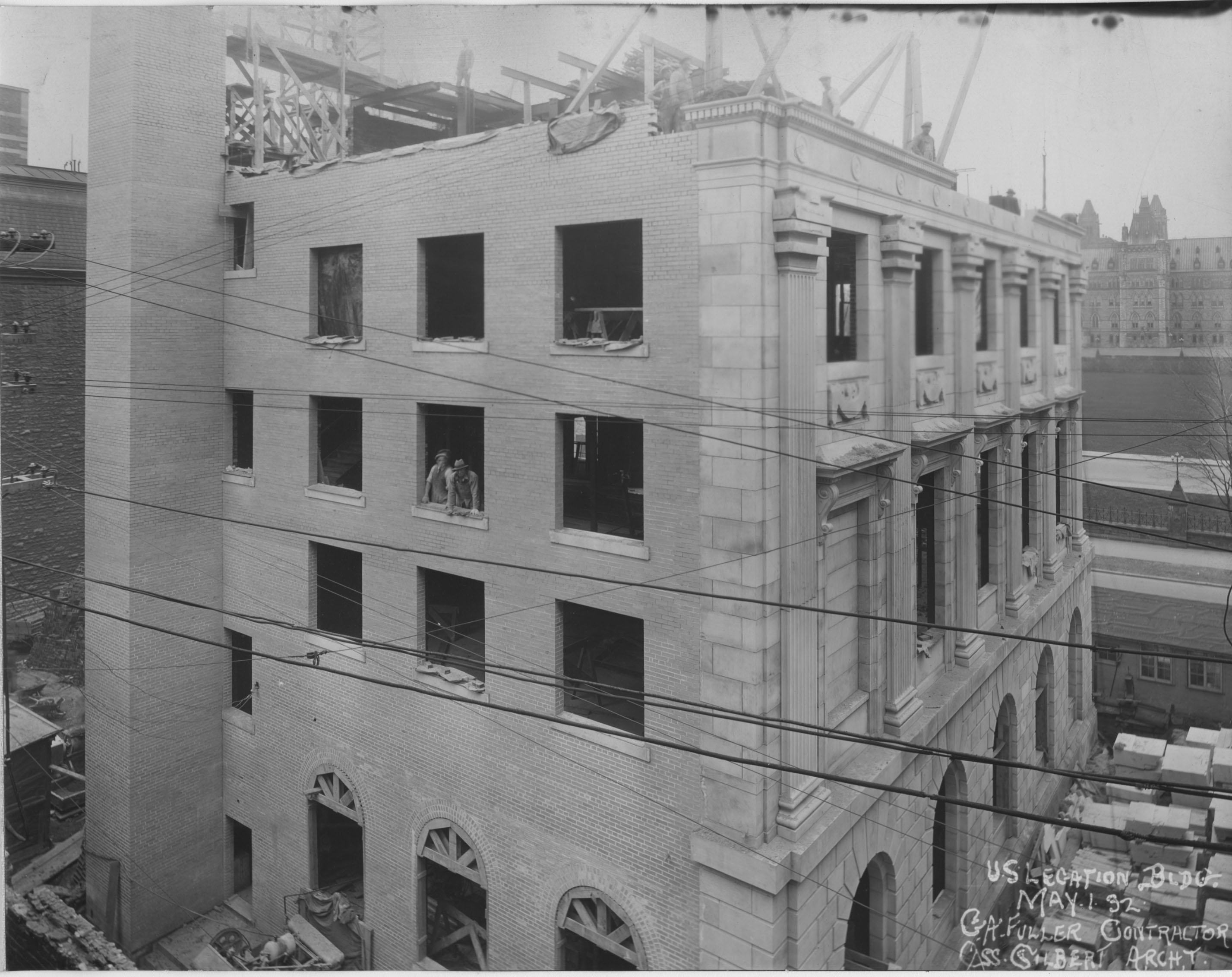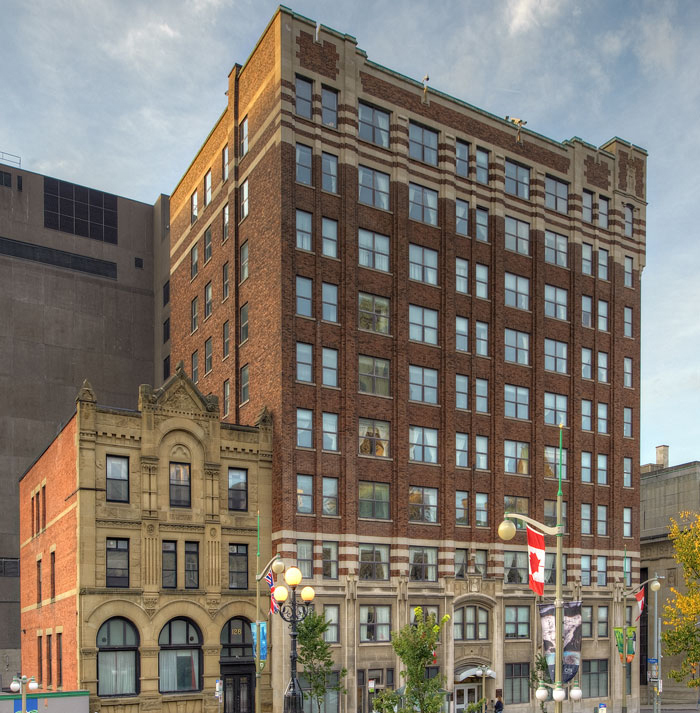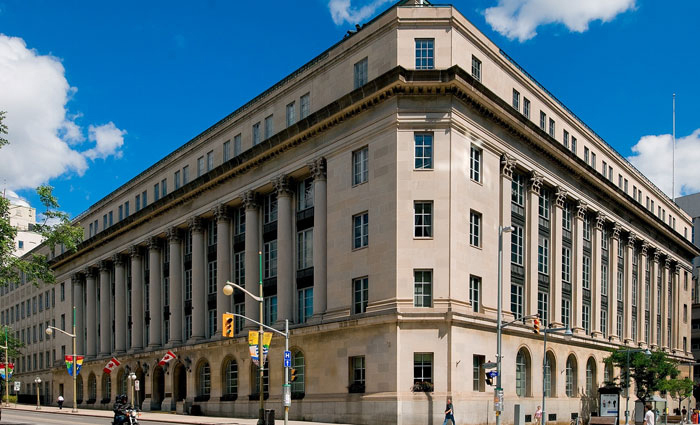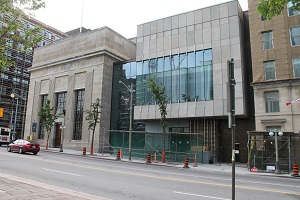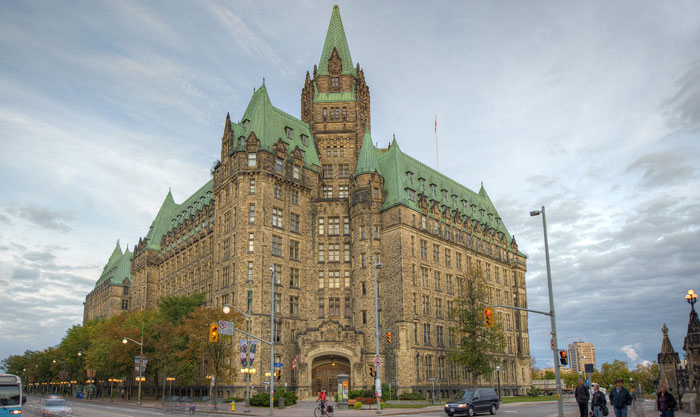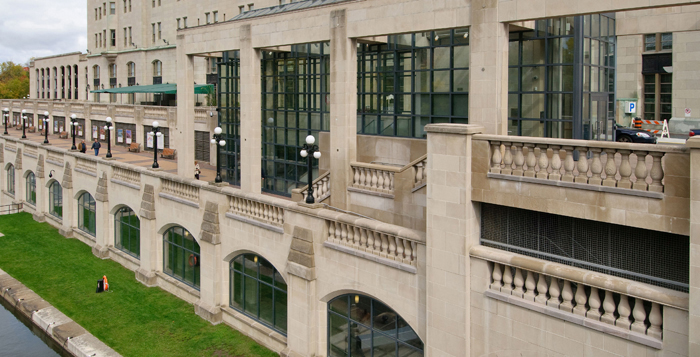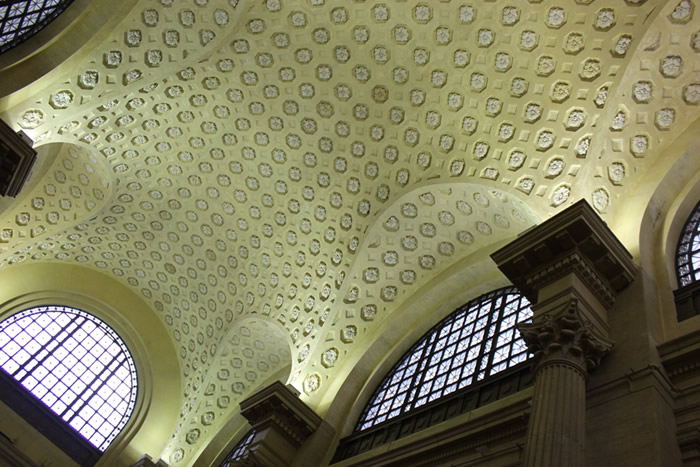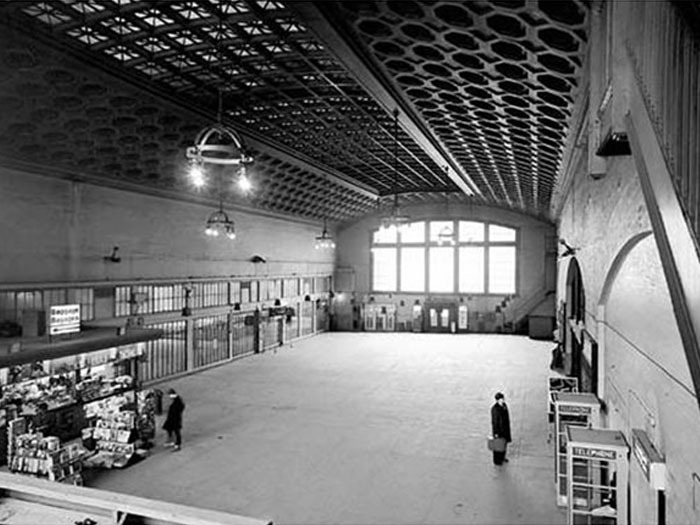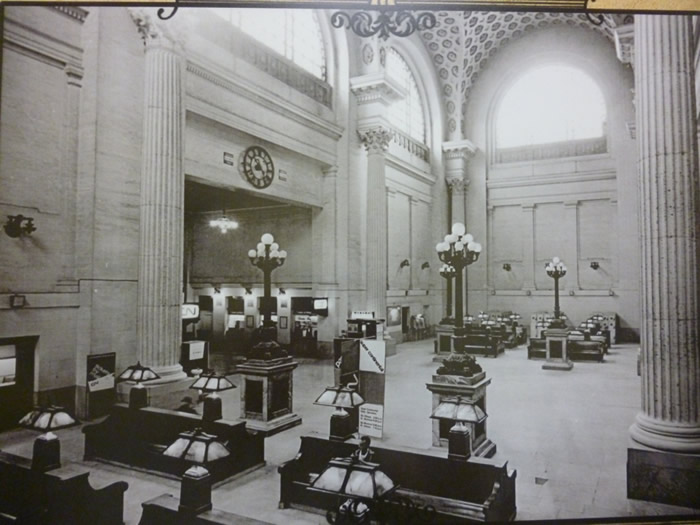Explore the buildings near Parliament Hill
There are a number of buildings located near Parliament Hill that serve Parliament. Learn about the history, art and architecture of these heritage buildings.
100 Wellington Street
History and architecture
100 Wellington has it all: it’s an architectural gem, in a unique location, with a special history.
Built in 1931 to 1932, the former U.S. Embassy at 100 Wellington Street is located prominently across from Parliament Hill. Designed in a classic Beaux-Arts style and finished in limestone, the building was designated as a Classified Federal Heritage Building in 1985.
The building’s balanced composition is centered on its main entrance. The main façades feature finely carved limestone details, gate posts with iron railings, arches and light fixtures, wood entrance doors, and multi-paned, double-vertical-sliding windows.
The interior features heritage elements such as marble walls, the original 1930s elevator and mahogany paneling throughout the interior. Its grand character is enhanced by significant natural sunlight from the many windows on three sides of the building. These windows also provide stunning and unique views of Parliament Hill.
Future use of the building
On June 21, 2017, following a broad consultation process, the Government of Canada announced the future use of 100 Wellington. The heritage building has been vacant since 1998.
Justice Building
History and architecture
The Justice Building was built from 1935 to 1938, based on designs by the architectural partnership of C.J. Burritt and Allan Horwood, and under the supervision of chief architect Thomas Fuller. In 1988, the Justice Building was designated a Recognized Federal Heritage Building for its historical, architectural and environmental values.
The building's architectural style is in the Chateau style, found in many of the grand hotels of the day. Its location was largely determined by federal planning studies between 1904 and 1938 aimed at developing Wellington Street into a grand avenue worthy of a national capital.
Originally, the building provided working and living space for the Royal Canadian Mounted Police. Between 1998 and 2001, the Justice Building was renovated to create permanent office space for 85 members of Parliament and their staff.
Valour Building
History and rehabilitation
Built in 1972, this Sparks Street building is a perfect choice for temporary relocation space while we are rehabilitating the West Block.
In preparation for its use by the House of Commons, this building underwent a rehabilitation of its own. Significant upgrades to its exterior and to its mechanical and electrical systems were completed, and three new committee rooms were added. In December 2010, the renovated building welcomed 62 members of Parliament.
Honouring our troops
On May 8, 2014, on the eve of the National Day of Honour, the office tower was renamed the Valour Building to commemorate the heroic contributions and ultimate sacrifices made by military heroes and Canadian civilians during Canada's mission in Afghanistan.
Victoria Building
History and architecture
Designed by John Albert Ewart and built from 1927 to 1928, the Victoria Building is a federal government office building. In 1987, the Victoria Building was designated as a Recognized Federal Heritage Building for its historical, architectural and environmental value.
The red brick and limestone building was one of the first high-rises in Ottawa. Built by the Wellington Investments Company, it was leased by the Canadian Broadcasting Corporation from 1938 to 1964. In 1973, the federal government purchased the building.
The Victoria Building remains largely unchanged and matches the urban character of the city's Wellington Street corridor in front of Parliament Hill. It is a familiar landmark to residents and parliamentarians.
Currently, the Victoria Building houses 40 offices for senators and has four committee rooms.
Wellington Building
History and architecture
The Wellington Building was designed in the Beaux-Arts style by the collaborative efforts of American architect D. Everett Waid and J.A. Ewart, of Ottawa. Built for the Metropolitan Life Insurance Company, the building features three-storey Corinthian columns, a cast steel and glass canopy entrance, marble floors and walls, and coffered beam ceilings accented by cast plaster detailing.
The main entrance lobby displays a dramatic ceiling mosaic created by American muralist Barry Faulkner. The mosaic, consisting of thousands of coloured ceramic squares and symbolizing health and well-being, was considered one of the finest designs of the era.
Learn about restoring the lobby mosaic.
Built in 1927, the Wellington Building's efficient office layout and the designers' concern for workplace health were ahead of their time. Later add-ons from the 1950s—a period of rapidly changing architectural tastes—reflected the insurance company's growth at the expense of ornate exterior decor and detail.
The building was acquired by the federal government in 1973. In 1986, the Wellington Building was designated as a Recognized Federal Heritage Building.
Learn about rehabilitating the Wellington Building.
Sir John A. Macdonald Building
History and architecture
Designed by Montreal architect Ernest Barott and built in 1932 for the Bank of Montreal, the Sir John A. Macdonald Building, renamed in honour of Canada's first prime minister, is a harmonious blend of Beaux-Arts and Art Deco architecture and design. In 1973, the bank sold the building to the federal government, but remained the building's sole tenant until 2005. In 1986, the Sir John A. Macdonald Building was designated as a Classified Federal Heritage Building.
Sitting above the external doors and windows are panels of limestone carvings that depict Canadian industry and commerce. Inside the building, decorations featuring Canada's wildlife and nature are found throughout. Despite the Great Depression, the bank fully completed the building—a structure that, like the bank itself, signified both stability and reliability.
Given its age, condition, prominence and strategic location near Parliament Hill, work began in 2010 to rehabilitate and expand the nearly 80-year-old building for parliamentary functions. The building was completed in 2015.
Learn about rehabilitating the Sir John A. Macdonald Building.
Confederation Building
History and architecture
The Confederation Building, built from 1927 to 1932, was the first major component of a new federal government precinct in the area west of Parliament Hill. The V-shaped Chateau-style building was designed by the Chief Architect's Branch of the Department of Public Works.
The building's exterior walls feature course stonework, and the building is topped with a copper roof. Although the exterior is virtually unchanged since 1932, the building's interior was rehabilitated in the 1970s to house government ministers and members of Parliament.
Based on its imposing size, prominent location and rich architectural details, the Confederation Building was designated as a Classified Federal Heritage Building in 1988.
Rehabilitation
in 2011, work to rehabilitate the Confederation Building began. That year, 234 of the building's windows were stabilized and, in 2012, the water system underwent improvements. The building's eight elevators were updated in 2014, and, the following year, the rehabilitation of its additional windows began.
Rideau Committee Rooms
Rehabilitation
The Rideau Committee Rooms, at 1 Wellington Street, were built in 1992 and are just east of Parliament Hill, between the Rideau Canal and the Chateau Laurier.
Starting in 2010, the Rideau Committee Rooms were modernized to support parliamentary operations while the West Block is being rehabilitated.
Government Conference Centre
History and architecture
The Government Conference Centre, built from 1909 to 1912, was Ottawa's central train station—Union Station—until 1966. It was converted to a government conference centre in 1968 to 1969.
The building was designed in the Beaux-Arts style by New York-based architect Bradford Lee Gilbert before being taken over by Ross and MacFarlane, a renowned Montreal-based firm that was responsible for many Canadian architectural treasures.
The former Union Station is a rare Canadian example of City Beautiful-inspired urban planning and it embodies the dignified and theatrical quality of the best examples of pre-First World War train stations.
The building's interior is a grand space that was inspired by classical Roman baths. The likeness is especially evident in the general waiting room, which is dominated by an elegant barrel-vaulted ceiling that is patterned with decorative coffers.
Five distinct blocks make up this building, four of which were built as part of the original train station: the main entrance, the general waiting room, the ticketing block and the concourse. The original train sheds at the southern end of the building were demolished and replaced with a new main entrance.
A meeting place
Since its transformation to the Government Conference Centre, events of national and international significance have taken place within its walls. Examples include:
- constitutional talks in November 1981, which led to the repatriation of the Constitution and the Canadian Charter of Rights and Freedoms (1982);
- the "Open Skies" Conference in February 1990, which contributed to the reunification of Germany;
- the Ottawa Treaty, or Anti-Personnel Mine Ban Convention, which was signed in December 1997 and led to a program to de-mine former conflict zones around the world;
- the G20 Conference in November 2001, which represented the first opportunity for the international community to meet and discuss the response to the events of September 11, 2001; and
- the annual federal budget lock-ups, where journalists are briefed in advance of the budget speech.
The Government Conference Centre was designated a Classified Federal Heritage Building in 1989 because of its historical associations, architectural value, and environmental impact as a familiar landmark of the city and the region.
Learn about rehabilitating the Government Conference Centre.
